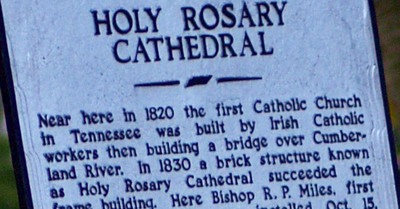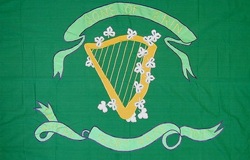
Photo by Chris Wage. Used with permission.
"Irish communities, or culturally-distinct ethnic enclaves, thrived in major cities across the South"
"The Irish of Nashville during the 1850s formed a political and military body to consolidate power, enhance social standing..."From Irish Confederates: the Civil War's Forgotten Soldiers, by Phillip Thomas Tucker (2007):
Irish communities, or culturally-distinct ethnic enclaves, thrived in major cities across the South... As in Ireland, these neighborhoods centered around the Catholic church, and the working class Irish (mostly Catholic immigrants) lived in overcrowded boarding houses, dirty tenement slums, and rough shanty towns that were as Gaelic in cultural terms as Dublin, Cork, or Galway in Ireland. pp. 25-26
In total, the Second Tennessee Confederate Infantry was composed of seven companies of Irish soldiers. Irishmen also volunteered in large numbers in the state capital of Nashville. Like the Tenth Tennessee Infantry Regiment of Volunteers (Irish), the Fifth Tennessee Confederate Infantry "was composed almost entirely of Irishmen." p. 27
Consisting primarily of common laborers, carpenters, and artisans, the Irish of Nashville during the 1850s formed a political and military body to consolidate power, enhance social standing, and to politically oppose the anti-Irish Know-Nothing Party. The enterprising immigrants established the appropriately named St. Patrick's Club in antebellum Nashville, and proudly dubbed themselves the "Sons of Erin." This fraternal organization served as the nucleus of an Irish militia unit that was organized in April 1861 - the Tenth Tennessee Infantry Regiment of Volunteers (Irish). Randal W. McGavock became the group's commander, thanks in part to the support of the large, vibrant Irish community of Nashville. pp. 101-102
In late May 1861 at Fort Donelson, the Tenth Tennessee Infantry Regiment of Volunteers (Irish) completed its organization, forming an ethnically distinct Irish Tennessee State militia regiment. These Irishmen in gray not only spoke a blend of middle Tennessee with an Irish brogue, but also Gaelic from the old country. p. 102
These Rebels marched to war under a colorful green battle-flag, decorated with the proud words "Sons of Erin" above the gold harp of Ireland, shamrocks, and the inspiring motto "Where Glory Waits You" below the Irish harp. pp. 102-103

Sons of Erin flag, GettysburgMuseum.com
In his book Furl That Banner: The Life of Abram J. Ryan, Poet-Priest of the South (2006), author David O'Connell describes a poem written by Abram J. Ryan and published in the Nashville Gazette on November 15, 1865:
The inspiration for "Erin's Flag" seems to have resulted from Ryan's close association with the famous Tennessee 10th, and shows that it was no mere accident that he had been asked to preach at the cathedral on the previous St. Patrick's Day. All ten of the regiment's companies, seven of which were from Nashville, had been made up of predominantly Irish immigrants or sons of Irish immigrants. They had flown the green flag of Ireland through all their campaigns, and Ryan alludes to it in the opening verses of the poem: "Unroll Erin's Flag! Fling its folds to the breeze! / Let it float o'er the land, let it flash o'er the seas." p. 65It wasn't just the Irish who lived in cultural enclaves in Nashville. The Germans in Nashville had their own church starting at about this same time period and worshipped there in German for the next 50 years. See the Hispanic Nashville Notebook story here.

No comments:
Post a Comment